The Evolution of China’s International Aviation Markets from a Policy Perspective on Air Passenger Flows
Abstract
:1. Introduction
2. The Historical Development of China’s International Aviation Markets
2.1. The Start of China’s International Aviation Markets (1937–1990)
2.1.1. Pre-PRC Era
2.1.2. Pre-Reform ERA (1949–1978)
2.1.3. Post-Reform ERA (1978–1990)
2.2. The Formation of China’s International Air Networks (1990–2000)
2.3. The Rapid Expansion of China’s International Air Networks (2001–Present)
3. The Evolution of China’s International Air Networks
3.1. The Spatial Distribution of China’s International Air Networks
3.1.1. Connected International Cities and Regions
3.1.2. Connected International Routes
3.2. The Clustering Characteristics of International Air Passengers
4. The Potential Determinants for the Evolution of China’s International Air Networks
4.1. Average International Air Travel Distance
4.2. Institutional and Policy Changes
4.3. Increasing Foreign Trade and Foreign Tourism
5. Conclusions and Discussion
Author Contributions
Funding
Conflicts of Interest
References
- Derudder, B.; Witlox, F. Mapping world city networks through airline flows: context, relevance, and problems. J. Transp. Geogr. 2008, 16, 305–312. [Google Scholar] [CrossRef]
- Allroggen, F.; Wittman, M.D.; Malina, R. How air transport connects the world - A new metric of air connectivity and its evolution between 1990 and 2012. Transp. Res. Part E Logist. Transp. Rev. 2015, 80, 184–201. [Google Scholar] [CrossRef]
- Wandelt, S.; Sun, X. Evolution of the international air transportation country network from 2002 to 2013. Transp. Res. Part E Logist. Transp. Rev. 2015, 82, 55–78. [Google Scholar] [CrossRef]
- Dobruszkes, F. Does liberalisation of air transport imply increasing competition? Lessons from the European case. Transp. Policy 2009, 16, 29–39. [Google Scholar] [CrossRef]
- Bettini, H.F.A.J.; Oliveira, A.V.M. Airline capacity setting after re-regulation: The Brazilian case in the early 2000s. J. Air Transp. Manag. 2008, 14, 289–292. [Google Scholar] [CrossRef]
- Koo, T.T.R.; Lohmann, G. The spatial effects of domestic aviation deregulation: a comparative study of Australian and Brazilian seat capacity, 1986–2010. J. Transp. Geogr. 2013, 29, 52–62. [Google Scholar] [CrossRef]
- Wang, J.; Bonilla, D.; Banister, D. Air deregulation in China and its impact on airline competition 1994-2012. J. Transp. Geogr. 2016, 50, 12–23. [Google Scholar] [CrossRef]
- Shaw, S.L.; Lu, F.; Chen, J.; Zhou, C. China’s airline consolidation and its effects on domestic airline networks and competition. J. Transp. Geogr. 2009, 17, 293–305. [Google Scholar] [CrossRef]
- Zhang, A. Industrial reform and air transport development in China. J. Air Transp. Manag. 1998, 4, 155–164. [Google Scholar] [CrossRef]
- Oman Aviation Group (OAG). OAG Take-Off: Essential Metrics on the World’s Major Airline; Oman Aviation Group: Luton, UK, 2017. [Google Scholar]
- Fu, X.; Zhang, A.; Lei, Z. Will China’s airline industry survive the entry of high-speed rail? Res. Transp. Econ. 2012, 35, 13–25. [Google Scholar] [CrossRef]
- Zhang, Q.; Yang, H.; Wang, Q.; Zhang, A. Market power and its determinants in the Chinese airline industry. Transp. Res. Part A Policy Pract. 2014, 64, 1–13. [Google Scholar] [CrossRef]
- Wang, J.; Wang, H.; Jiao, J. China’s international aviation transport to the Belt and Road Initiative area. Prog. Geogr. 2015, 34, 554–562. [Google Scholar]
- Liu, W.; Dunford, M. Inclusive globalization: unpacking China’s Belt and Road Initiative. Area Dev. Policy 2016, 1, 323–340. [Google Scholar] [CrossRef]
- International Air Transport Association (IATA). World Air Transport Statistics 2017 Mediaki Edition; International Air Transport Association: Montreal, QC, Canada, 2017. [Google Scholar]
- Zhang, A.; Chen, H. Evolution of China ’ s air transport development and policy towards internation. Transp. J. 2003, 42, 31–49. [Google Scholar]
- Jin, F.J.; Wang, F.H.; Liu, Y. Geographic Patterns of Air Passenger Transport in China 1980 – 1998: Imprints of Economic Growth, Regional Inequality, and Network Development. Prof. Geogr. 2004, 56, 471–487. [Google Scholar]
- Zhang, Y.; Round, D.K. China’s airline deregulation since 1997 and the driving forces behind the 2002 airline consolidations. J. Air Transp. Manag. 2008, 14, 130–142. [Google Scholar] [CrossRef]
- Du, W.-B.; Zhou, X.-L.; Lordan, O.; Wang, Z.; Zhao, C.; Zhu, Y.-B. Analysis of the Chinese Airline Network as multi-layer networks. Transp. Res. Part E Logist. Transp. Rev. 2016, 89, 108–116. [Google Scholar] [CrossRef] [Green Version]
- Wang, J.; Mo, H.; Wang, F. Evolution of air transport network of China 1930–2012. J. Transp. Geogr. 2014, 40, 145–158. [Google Scholar] [CrossRef]
- Lei, Z.; O’Connell, J.F. The evolving landscape of Chinese aviation policies and impact of a deregulating environment on Chinese carriers. J. Transp. Geogr. 2011, 19, 829–839. [Google Scholar] [CrossRef]
- Chang, Y.-C.; Hsu, C.-J.; Lin, J.-R. A historic move – the opening of direct flights between Taiwan and China. J. Transp. Geogr. 2011, 19, 255–264. [Google Scholar] [CrossRef]
- Ma, X.; Timberlake, M.F. Identifying China’s leading world city: a network approach. GeoJournal 2008, 71, 19–35. [Google Scholar] [CrossRef]
- Jiang, C. The history of China’s aviation; Tsinghua University: Beijing, 2000. [Google Scholar]
- Wang, C.; Jin, F. Spatial evolement of China inernational relation through analyzing aviation international networks. Econ. Geogr. 2005, 25, 667–672. [Google Scholar]
- Zhang, Q.; Yang, H.; Wang, Q. Market conduct of the three busiest airline routes in China. J. Transp. Econ. Policy 2013, 47, 335–347. [Google Scholar]
- Zhao, S.X.B.; Zhang, L. Foreign Direct Investment and the Formation of Global City-Regions in China. Reg. Stud. 2007, 41, 979–994. [Google Scholar] [CrossRef]
- Van De Vijver, E.; Derudder, B.; Witlox, F. Exploring causality in trade and air passenger travel relationships: the case of Asia-Pacific, 1980–2010. J. Transp. Geogr. 2014, 34, 142–150. [Google Scholar] [CrossRef]
- Yang, H.; Dobruszkes, F.; Wang, J.; Dijst, M.; Witte, P. Comparing China’s urban systems in high-speed railway and airline networks. J. Transp. Geogr. 2018, 68, 233–244. [Google Scholar] [CrossRef]
- Neal, Z. The devil is in the details: Differences in air traffic networks by scale, species, and season. Soc. Networks 2014, 38, 63–73. [Google Scholar] [CrossRef]
- Lei, Z.; Yu, M.; Chen, R.; O’Connell, J.F. Liberalization of China-US air transport market: Assessing the impacts of the 2004 and 2007 protocols. J. Transp. Geogr. 2016, 50, 24–32. [Google Scholar] [CrossRef]
- Zhang, Y.; Zheng, X.; Lu, W. Measuring the openness of Chinese international air transport policy. Transp. Policy 2018, 1–10. [Google Scholar] [CrossRef]
- Zhao, X. International Air Transportation Liberalization and China’sAir Transport Industry. Air Transp. 2007, 75, 58–62. [Google Scholar]
- Ren, S.; Yuan, B.; Ma, X.; Chen, X. International trade, FDI (foreign direct investment) and embodied CO2 emissions: A case study of chinas industrial sectors. China Econ. Rev. 2014, 28, 123–134. [Google Scholar] [CrossRef]
- Graham, A. Managing Airports, Third Edition: An international perspective, 3rd ed.; Routledge: London, UK, 2009. [Google Scholar]
- Liu, G.; Hu, J. Study on measurement of relationship between China ’ s foreign trade and air transport growth. Air Transp. 2015, 33, 36–40. [Google Scholar]
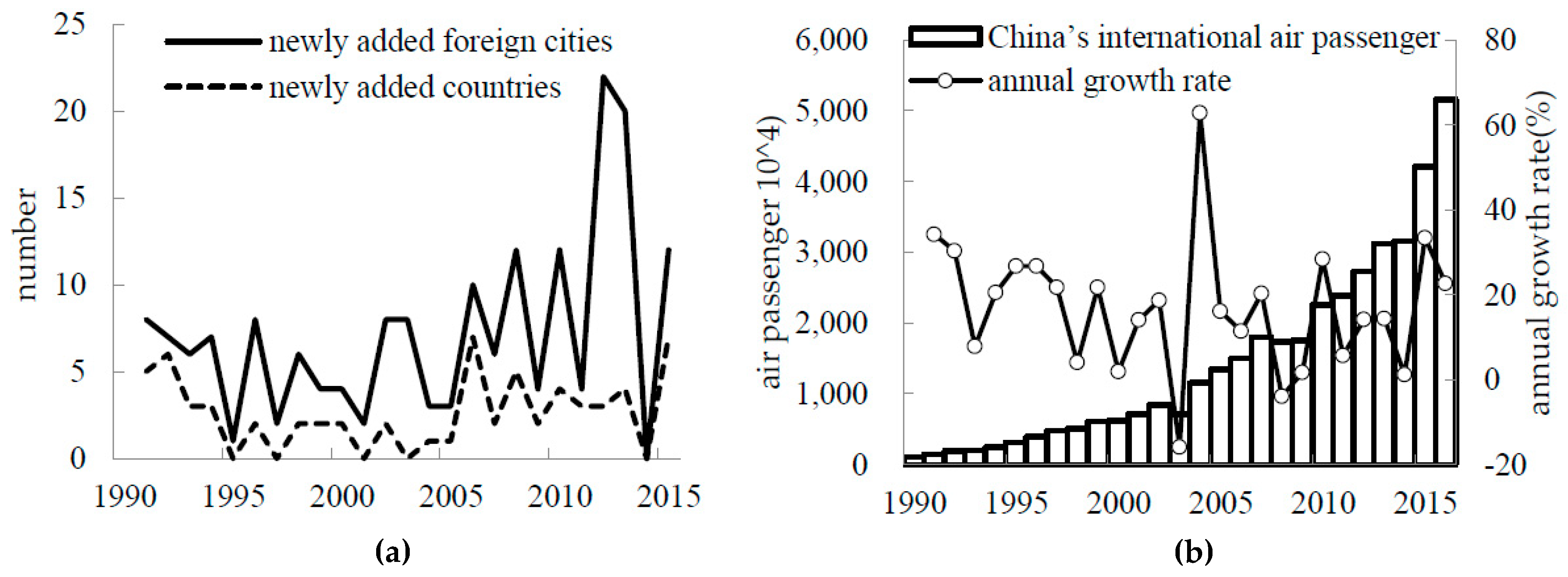
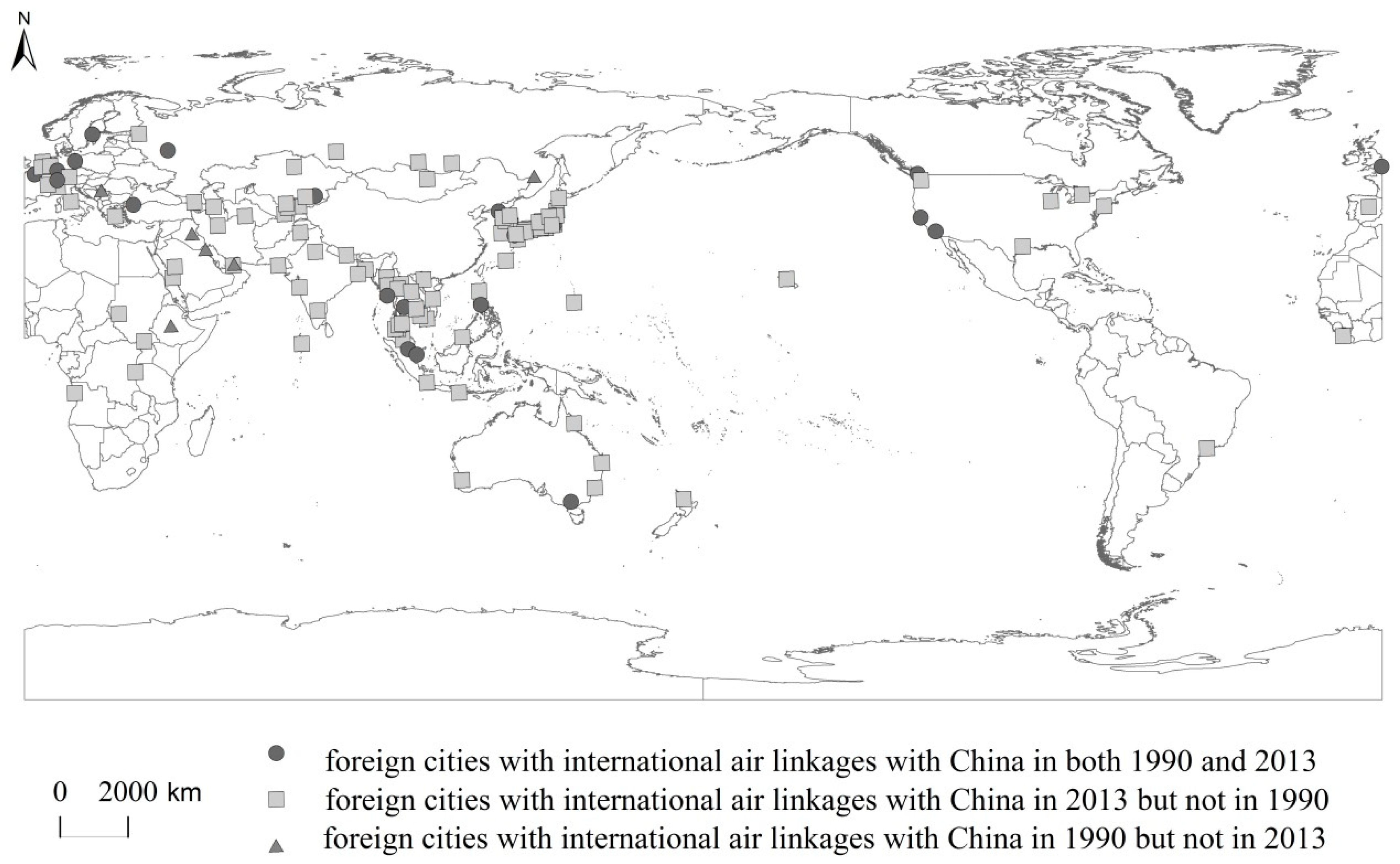
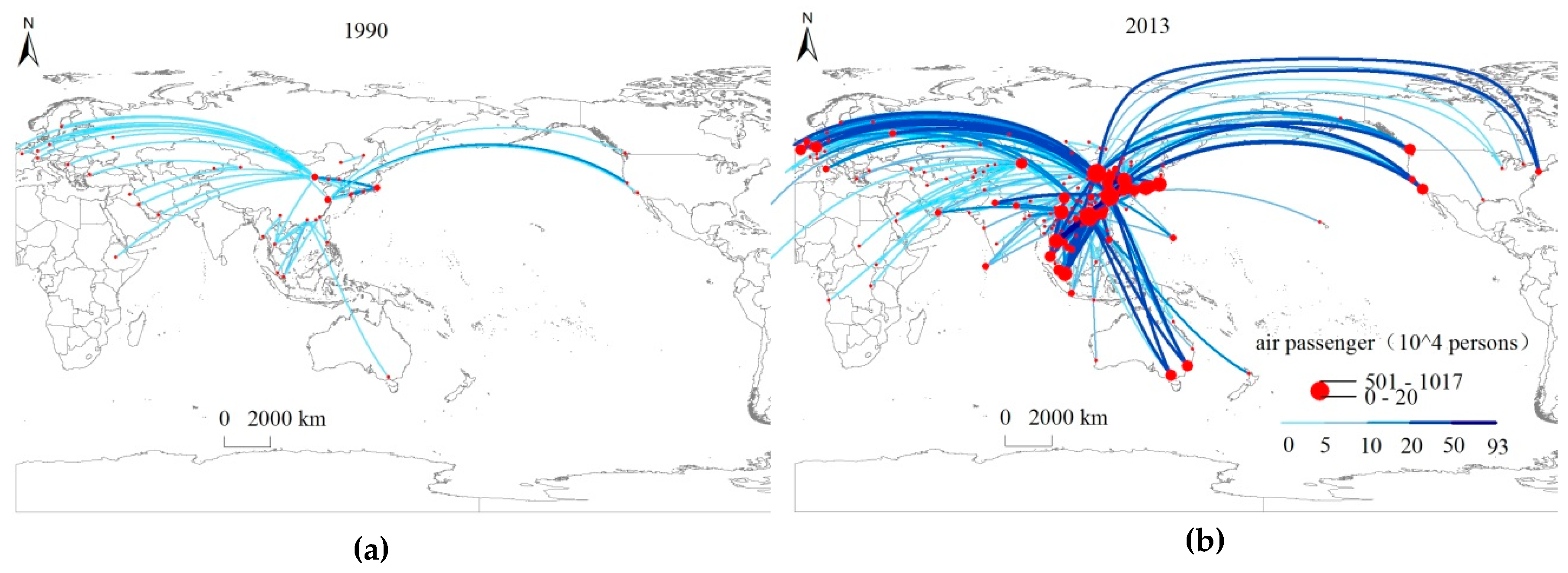
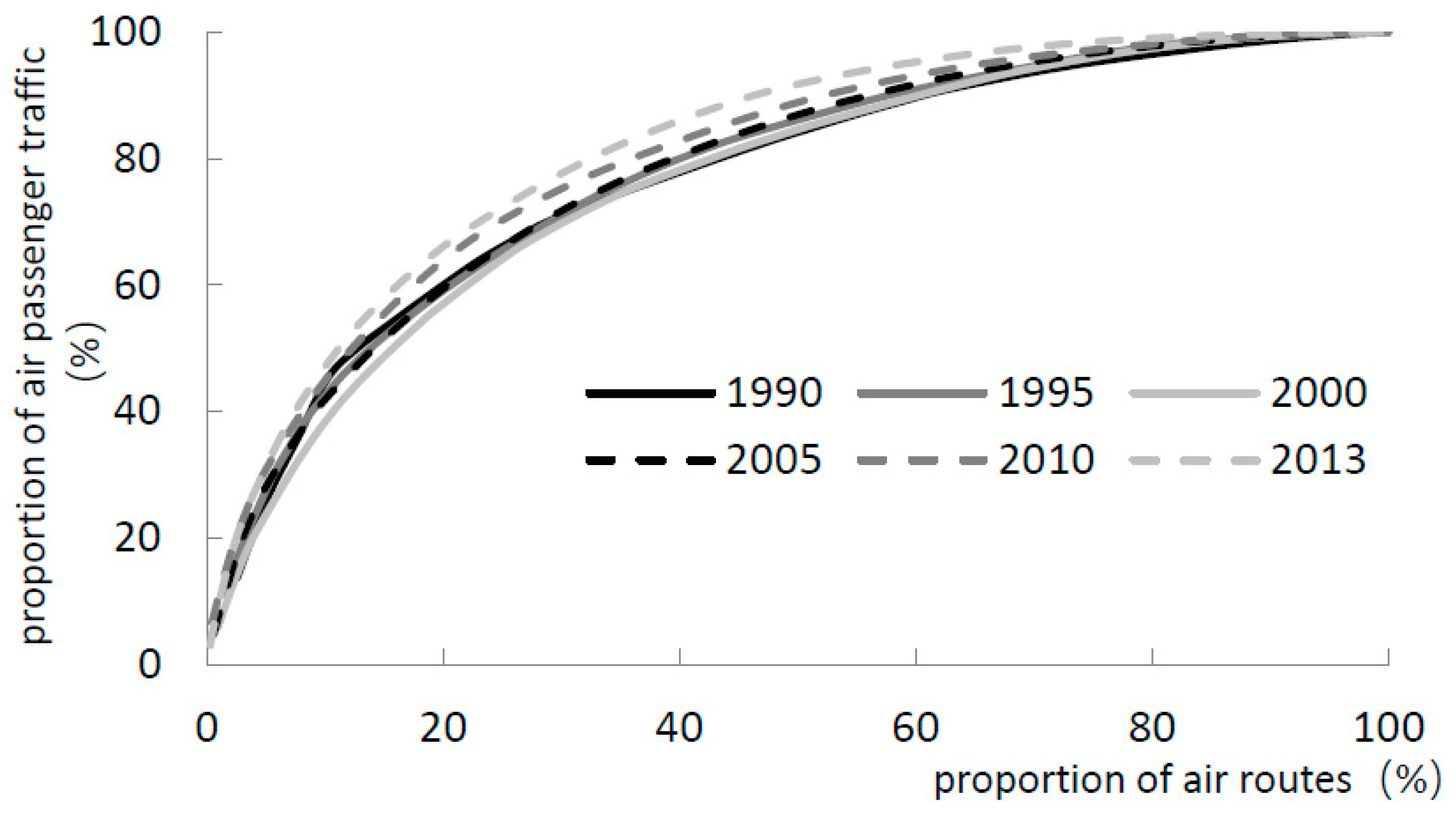
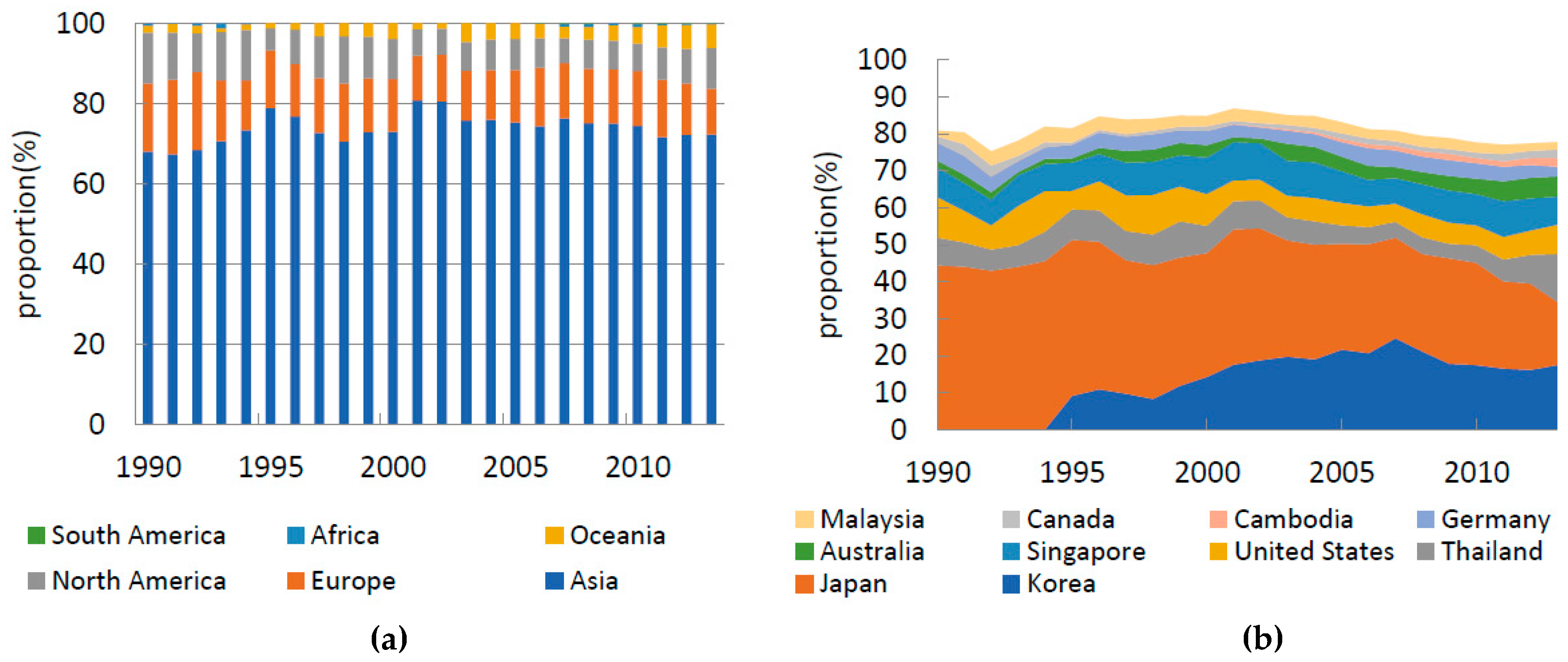
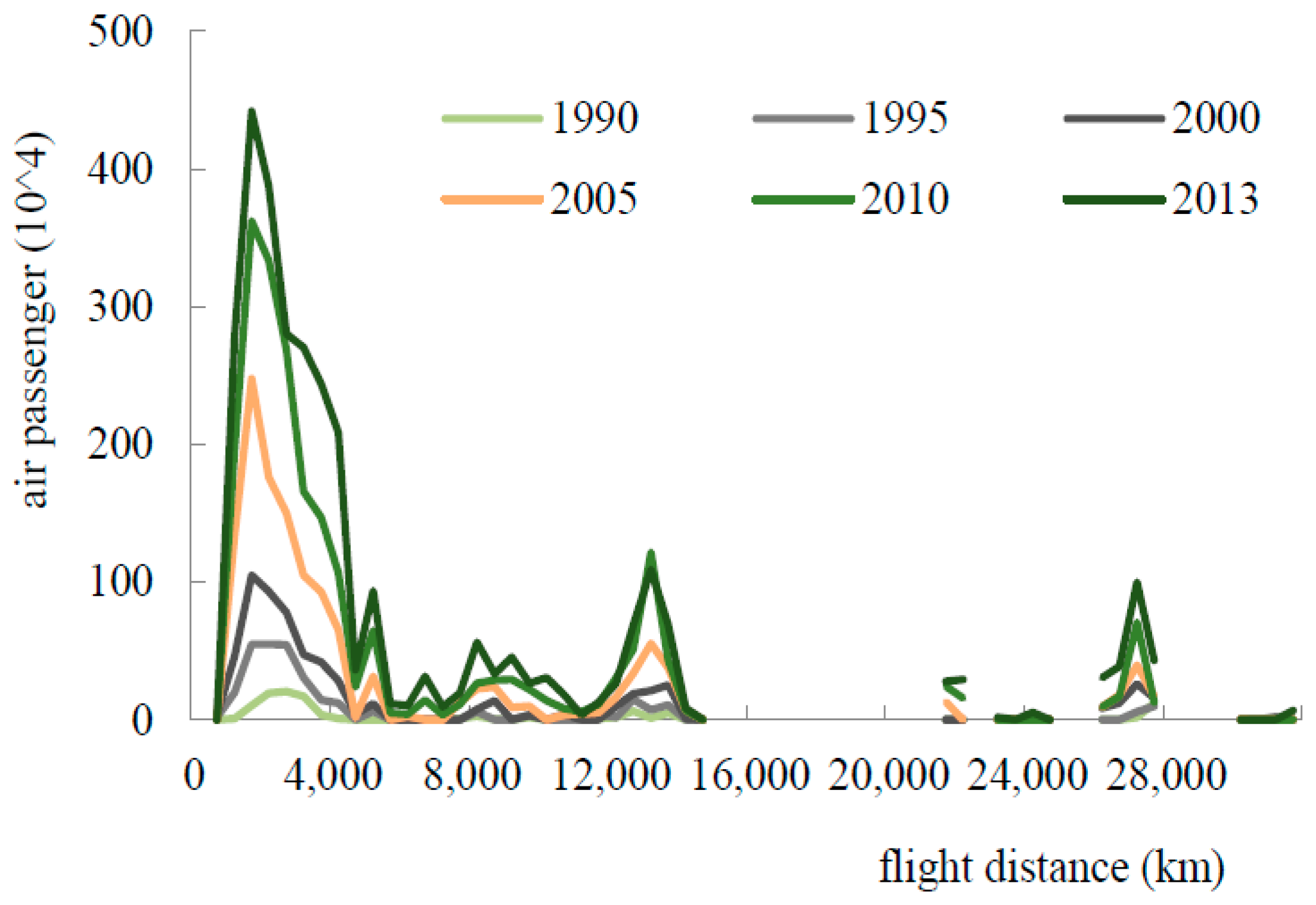
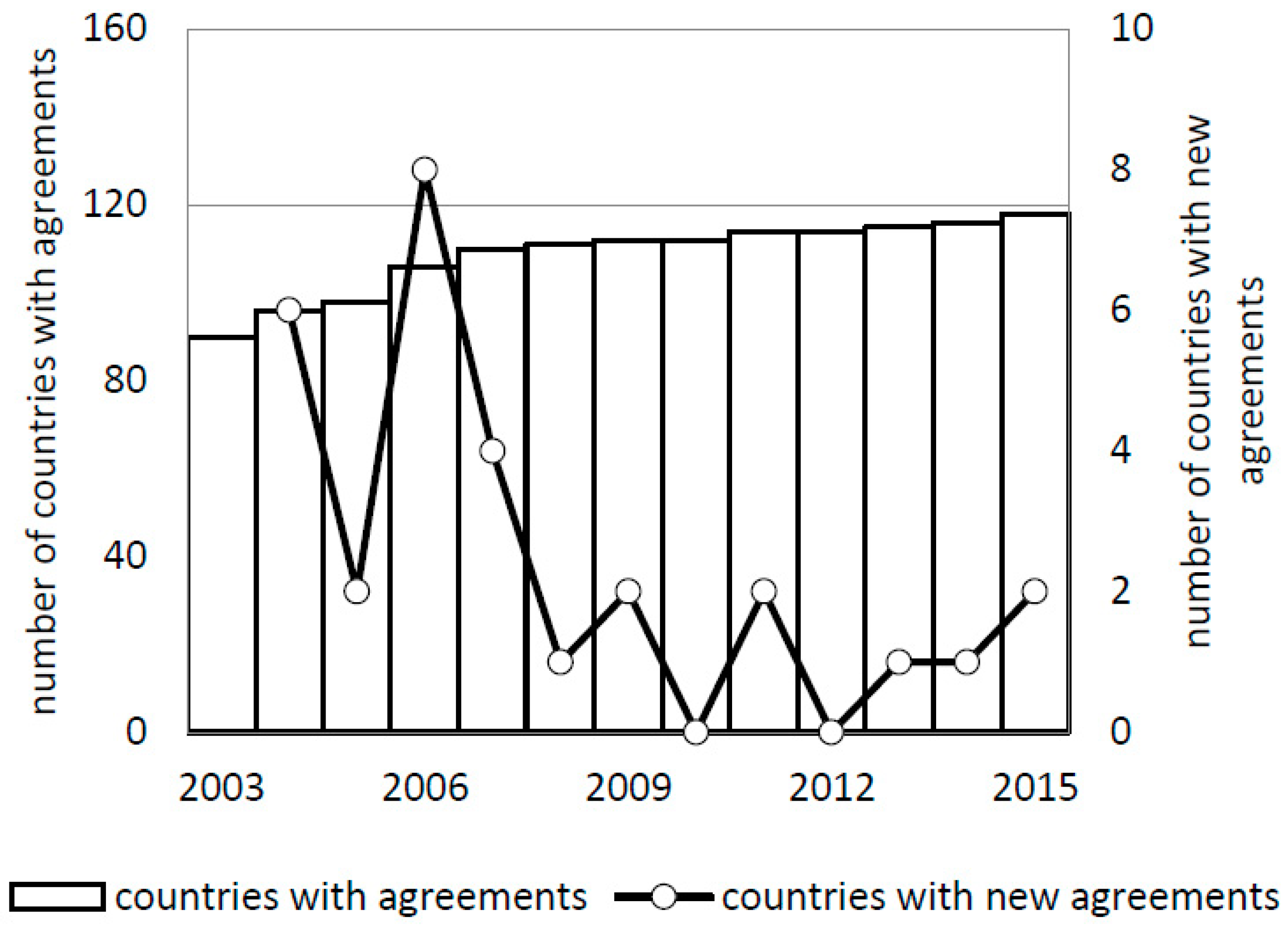
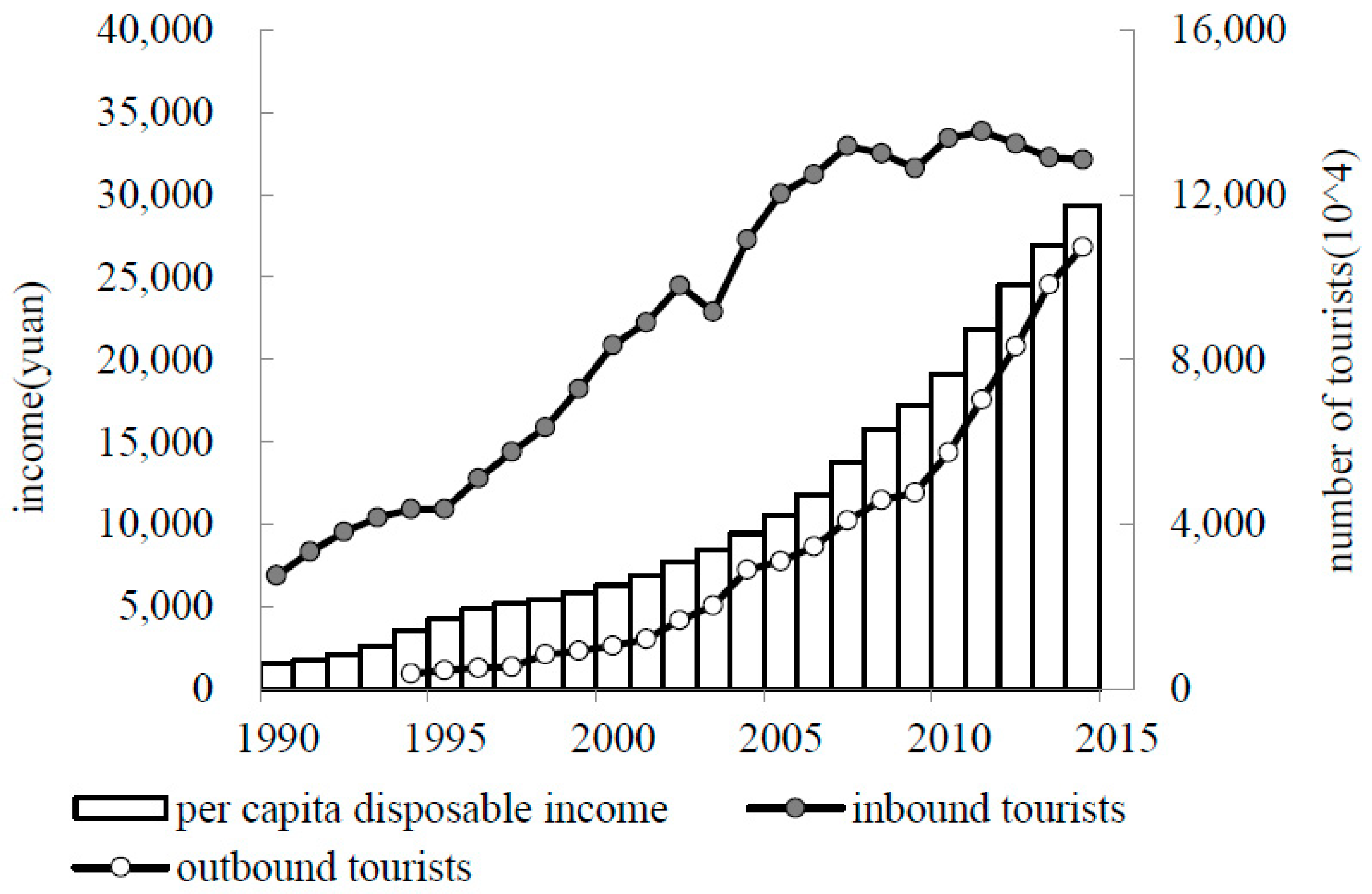
| Categories | 1990 | 1995 | 2000 | 2005 | 2010 | 2013 | 2014 | 2015 | 2016 |
|---|---|---|---|---|---|---|---|---|---|
| International air routes | 44 | 85 | 133 | 233 | 302 | 427 | 490 | 660 | 739 |
| The freq. of international airlines | 7216 | 17,278 | 36,909 | 92,852 | 147,488 | 243,541 | - | - | - |
| Foreign countries with international air travel with China | 24 | 31 | 33 | 33 | 54 | 50 | 48 | 55 | 56 |
| Cities with international aviation airports | 9 | 14 | 22 | 27 | 33 | 50 | 51 | 51 | 77 |
| Foreign cities with international travel with China | 32 | 51 | 56 | 72 | 101 | 126 | 125 | 137 | 146 |
| International air passengers (1.0 × 104 persons) | 108.7 | 313.3 | 624.1 | 1343.5 | 2257.8 | 3118 | 3155 | 4207 | 5162 |
| International air cargos (1.0 × 104 t) | 7.5 | 17.4 | 45.0 | 76.4 | 185.5 | 176.0 | 168.4 | 186.8 | 193.2 |
| Foreign Cities with International Air Travel with China in 1995 | Opening Rate (%) | Foreign Cities with International Air Travel with China in 2000 | Opening Rate (%) | Foreign Cities with International Air Travel with China in 2013 | Opening Rate (%) | |
|---|---|---|---|---|---|---|
| Asia | 23 | 39.0 | 34 | 34.0 | 80 | 32.4 |
| Oceania | 2 | 13.3 | 3 | 17.6 | 6 | 23.1 |
| North America | 5 | 4.7 | 5 | 3.9 | 11 | 6.8 |
| Europe | 14 | 5.7 | 14 | 5.0 | 23 | 5.0 |
| Africa | 0 | 0 | 0 | 0 | 5 | 3.6 |
| South America | 0 | 0 | 0 | 0 | 1 | 1.0 |
| Average number | 44 | 8.6 | 56 | 8.5 | 126 | 11.1 |
| Rank | 1990 | Pax | Percentage (%) | 2000 | Pax | Percentage (%) | 2013 | Pax | Percentage (%) |
|---|---|---|---|---|---|---|---|---|---|
| 1 | Tokyo | 289,928 | 26.7 | Seoul | 824,188 | 13.2 | Seoul | 4,180,138 | 13.4 |
| 2 | Osaka | 138,377 | 12.7 | Tokyo | 637,780 | 10.2 | Bangkok | 2,880,578 | 9.2 |
| 3 | San Francisco | 104,173 | 9.6 | Singapore | 618,997 | 9.9 | Singapore | 2,385,773 | 7.7 |
| 4 | Singapore | 87,762 | 8.1 | Osaka | 505,087 | 8.1 | Tokyo | 1,467,716 | 4.7 |
| 5 | Bangkok | 81,961 | 7.5 | Bangkok | 459,019 | 7.4 | Osaka | 1,270,192 | 4.1 |
| 6 | Fukuoka | 48,035 | 4.4 | Los Angeles | 389,874 | 6.2 | Phuket | 941,823 | 3.0 |
| 7 | Frankfurt | 38,347 | 3.5 | Nagoya | 335,806 | 5.4 | Los Angeles | 920,871 | 3.0 |
| 8 | Paris | 32,604 | 3.0 | Fukuoka | 318,113 | 5.1 | Sydney | 891,433 | 2.9 |
| 9 | London | 30,559 | 2.8 | Paris | 209,700 | 3.4 | Nagoya | 856,924 | 2.7 |
| 10 | Manila | 29,556 | 2.7 | Frankfurt | 199,313 | 3.2 | Jeju | 732,070 | 2.3 |
| Total | 881,302 | 81 | 4,497,877 | 72.1 | 16,527,518 | 53 |
| Year | Equation |
|---|---|
| 1990 | y = 24.972ln(x) − 13.569, R2 = 0.9978 |
| 1995 | y = 24.579ln(x) − 11.195, R2 = 0.9881 |
| 2000 | y = 25.335ln(x) − 15.236, R2 = 0.9813 |
| 2005 | y = 24.027ln(x) − 8.6944, R2 = 0.9795 |
| 2010 | y = 22.774ln(x) − 2.1723, R2 = 0.9801 |
| 2013 | y = 22.589ln(x) + 0.2572, R2 =0.9763 |
© 2019 by the authors. Licensee MDPI, Basel, Switzerland. This article is an open access article distributed under the terms and conditions of the Creative Commons Attribution (CC BY) license (http://creativecommons.org/licenses/by/4.0/).
Share and Cite
Wang, J.; Yang, H.; Wang, H. The Evolution of China’s International Aviation Markets from a Policy Perspective on Air Passenger Flows. Sustainability 2019, 11, 3566. https://doi.org/10.3390/su11133566
Wang J, Yang H, Wang H. The Evolution of China’s International Aviation Markets from a Policy Perspective on Air Passenger Flows. Sustainability. 2019; 11(13):3566. https://doi.org/10.3390/su11133566
Chicago/Turabian StyleWang, Jiaoe, Haoran Yang, and Han Wang. 2019. "The Evolution of China’s International Aviation Markets from a Policy Perspective on Air Passenger Flows" Sustainability 11, no. 13: 3566. https://doi.org/10.3390/su11133566
APA StyleWang, J., Yang, H., & Wang, H. (2019). The Evolution of China’s International Aviation Markets from a Policy Perspective on Air Passenger Flows. Sustainability, 11(13), 3566. https://doi.org/10.3390/su11133566




